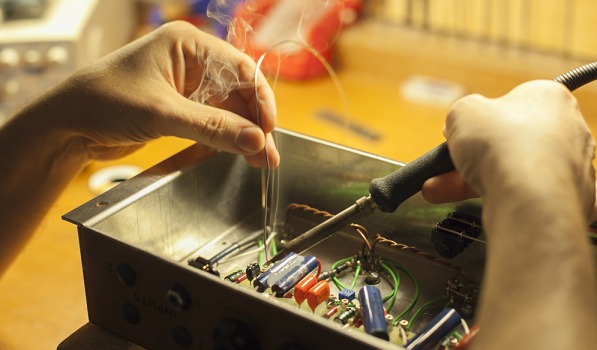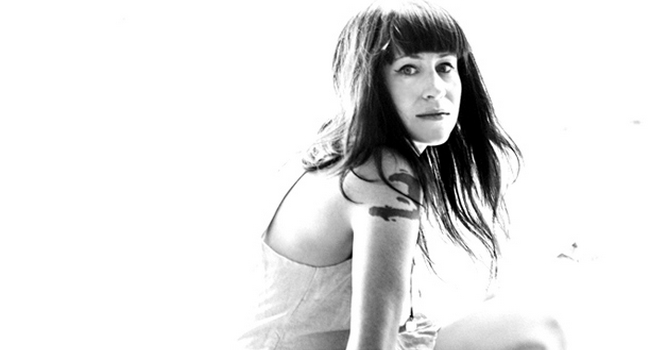If it sounds like Panda Riot’s music should be the soundtrack to a post-apocalyptic space fantasy art film, it’s not necessarily all in your imagination. After one full-length record and an EP (both self-released), the Chicago group released its new record through Dallas-based Saint Marie Records in February. The album, Northern Automatic Music, further refines the band’s cinematic sound by crafting a wash of shimmery guitars and underpinning it all with a newfound organic, rhythmic intricacy. Their female lead vocals are featured firmly on top, unlike other shoegazers My Bloody Valentine (the genre was so named for the UK quartet’s habit of staring at their shoes while playing live), a group which seemed to take great pains to bury their vocals alive.
Three of the now four members recently sat down on their vintage velvet sofa in their Humboldt Park rehearsal and recording space to share their stories, how they see the new record as a big step forward and what inspires them to create music. Resident cats Fakebooks and Phoebe roam freely and interject the occasional meow.
The duo (and couple) of Brian Cook and Rebecca Scott began Panda Riot in Philadelphia in response to accolades they received for the soundtrack to a short film they produced. Cook was a filmmaker first and foremost, and although he was asked to join a band in Philadelphia, he describes that involvement as a nervous experience.
“I couldn’t even stand up to play guitar,” he says. “I’d have to sit down to practice, and then as I got more comfortable with that, I realized that . . . I wanted to do my own thing, which was completely different from the band I was in.”
“I can’t even describe the feeling of being able to start to write these songs,” Cook says. For him, it was a definite eureka moment.
On the other hand, his other half, Scott, had always played music, but had never been in a band before, and although Cook says he “gets” some of the references that reviewers use when attempting to describe the band’s sound, more often than not Scott doesn’t.
“Obviously I like My Bloody Valentine and I’ve listened to some “shoegaze” bands that I like, but people will say, ‘Oh, this is a clear reference to this band,’ and I’ll think, ‘I don’t know who that band is; I’ve never listened to them before,'” Scott says.
According to Cook, they know of more shoegaze bands from reading Panda Riot reviews than from anything else. “A lot of times I feel like, if you’re looking for something, you’re going to find it, regardless of whether it’s true or not, and I feel like there are certain elements of our band that are shoegaze, but if you have that in mind from the get-go, you’re going to find a lot of those elements,” he says. “But if you don’t have that in mind, you’re going to see that the influences are way different than that one Jesus and Mary Chain track, for example.”
Scott admits to liking a lot of shoegaze bands, but is quick to avoid being pigeonholed. “[Shoegaze] is not a part of my identity as a musician or as a person or even as a fan. There’s a lot of different influences that come in from a lot of different places . . . people tend to make these associations with shoegaze but there’s a lot of other stuff going on I think.” she says. “I think it’s funny, because none of us, with the exception of Cory, comes from the “shoegaze” scene, so we don’t really know.”
Cory Osborne, the band’s new bassist, is a veteran of local bands Airiel and Lightfoils, and the missing fourth at practice. Osborne became a full-fledged member only within the past three or four months, and although Cook jokes that the previous bassist was texting on a motorcycle and drove off a cliff, with his ghost appearing on windy nights, the truth is far less interesting; Scott said he just had other commitments and was unable to keep playing with them.
Rounding out the quartet is the man who supplanted (or at least supplements) Panda Riot’s drum machine: Jose Rodriguez. Rodriguez explains that his former band toured the East Coast with Panda Riot and they invited him to play the song “Motown Glass” on tambourine. A jam session followed and from then on out he became a full member and added more live drum parts to the songs.
Indeed, Cook points to the addition of Rodriguez’s drum parts as one of the essential improvements on the new record.
“We wanted to add live drums, because from a performance perspective, you can just feel it more. The sound person has less control over how it sounds. We would play shows and in terms of how the audience heard the drum machine, they would set it at a really low setting, or set it too high and then all of a sudden it’s like a house track or something,” she says. “So for consistency’s sake, that was why we started to think about having live drums, but on the record, we spent a long time [thinking] how can we incorporate this and not just turn it into a rock band. We wanted to try to figure out a good blend, so I think the drums are a huge deal.”
In contrast with the band’s previous recordings is the prominence and intelligibility of the vocals and of Scott’s lyrics. Cook jokes that they were listening to a lot of Barbra Streisand, but Scott attributes it to becoming more confident with her singing. “With the first record, I was like, ‘It’s cool, bury it, bury it a little bit more,” she says.
Cook says the balance is better and the vocals are more prominent simply because he got better at mixing. “If anything, this is the record that I had 100% control over it as far as rerecording it and mixing it and having the time to do it, ” he says. He also felt Northern Automatic Music is a more poppy album and thought the vocals should be brought to the forefront.
Cook is surprised that none of their reviewers have brought up Mary Timony’s band Helium as a touchstone when describing the sound of Panda Riot. What he appreciates about Helium’s music (although he agrees that work is more of “a distorted band vibe kind of thing”), is at the heart of what they do: “really catchy pop songs, with the vocals not trying to be hidden. They’re way up front and they’re catchy.”
Influences, he argues, are important: “That’s what pushes music forward, taking these influences, putting them in a blender and seeing how they turn out,” he says. The group also points to Stereolab, Swirlies and Digable Planets as inspirations.
Cook explains that the process of writing these catchy pop song is often a labor of love. “[Scott] writes most of the lyrics and definitely the vocal melodies,” he says. “I can’t sing and I can’t even try to sing, so trying to explain to her what vocals I want is almost impossible. Sometimes I do hear a vocal melody and it’s like, ‘Have you ever seen that movie “Nell?”’ It’s just a bunch of grunts and hand movements trying to explain notes,” Cook says.
“I used to only make films, and I realized that visuals really inspire me to make music. A lot of times I’ll see something that looks very beautiful and not want to do something else not visually, but musically.”
Just as Panda Riot was borne of a film soundtrack project, Scott and Cook try to picture scenes while writing. They’re inspired by space films of the 1970’s, “Blade Runner,” and the Werner Herzog film “Aguirre, The Wrath Of God.” Scott says that Cook usually prefers post-apocalyptic bleak landscapes. “He’d rather have us sit on cinder blocks and slabs of concrete,” Scott says with a laugh.
Cook points to the work of abstract artist Joan Mitchell as an influence on the guitar sound of the new record, in particular her painting “City Landscape,” which is currently on exhibit at The Art Institute of Chicago.
In terms of playing live, they’ll mainly be playing in the Chicago area for now, but hope to book an East Coast tour for late summer as Scott and Cook both have flexible schedules. Scott has summers off from her graduate program in Philosophy at Loyola and Cook’s schedule as an in-home teacher of recording technology is flexible. Panda Riot also hopes to play some shows in Asia. The band signed to Vinyl Junkie in Japan and White Wabbit in Taiwan.
So far, the favorite road stories that spring to mind include the gigantic cup Rodriguez procured at a truck stop. “It was, like, 100 ounces,” Scott says. “It was basically a baby pool with a handle,” playing a tiny club in Athens, Georgia and meeting Michael Stipe, former leader of R.E.M., who bought Panda Riot’s CD.
As the headliner on a four-band bill at Township in Logan Square, Panda Riot rocketed gleefully through many of Northern Automatic Music’s highlights, including “Serious Radical Girls,” a seven inch single that was selling at the show. Panda Riot’s shimmering guitars created an oceanic wash of sound punctuated by Scott’s smiling soprano, Rodriguez and Osborne’s pummeling rhythm section, supplemented by programmed drums, and the occasional keyboard flourish from the lead singer.
The foursome opened with the lead track from the new record, “Amanda In The Clouds” and the set concluded with the fiercely bitter yet delicately layered “Black Pyramids,” and if the band couldn’t replicate the organic hand claps from the record in the live setting, they successfully recreated the talkative passion nonetheless.
That’s one of the primary charms of Panda Riot, and one of the reason the moniker is so fitting. Pandas may have a sweet image, but they’re really just big bears with sharp teeth who happen to enjoy bamboo. A riot of pandas could be a terrifying thing or a beautiful event. The band clearly produces the latter.






